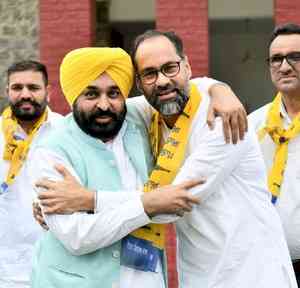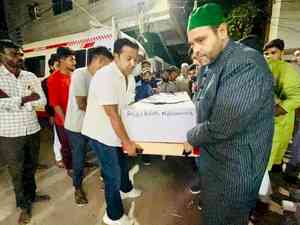109-year-old Woman Successfully Undergoes Difficult Surgical Procedure at Paras Hospitals
Author(s): City Air NewsGurgaon, January 25, 2016: A 109-year-old woman who had sustained a hip fracture in a fall has been successfully treated at Paras Hospital, Gurgaon with a new minimally invasive surgical technique that reduces the...

Gurgaon, January 25, 2016: A 109-year-old woman who had sustained a hip fracture in a fall has been successfully treated at Paras Hospital, Gurgaon with a new minimally invasive surgical technique that reduces the heightened risk of mortality and disability for fragile people of such advanced age.
Maya Devi incurred the hip fracture due to a fall at home. Hip fractures are common in elderly women and men but this condition is quite uncommon at her age as people of her age are not very active and not expected to be able to stand and move. Maya Devi, on the other hand was very active and capable of doing all her activities by herself. While reports suggested no trace of diabetes, she was diagnosed with hypertension.
The trivial fall at home resulted in fracture of the left hip and left wrist. The wrist fracture was extra-articular indicating that the fracture line did not extend into the joint, left proximal semoral fracture.
While this condition required a surgery for cure, it also has many associated complications that are often life threatening at this age. The risk of fragility fracture is 1 out of 3 in females and 1 out of 5 in males due to osteoporosis. First year mortality rate is as high as 26% in females and it is little higher at about 34% for males. People with hip fracture often require assistance for walking and standing. Refracture risk is more than 15 fold within a year for these patience’s.
“The chances of hip fracture increases with advancing age due to osteoporosis, which is a age-related negative bone balance which decreases after 40 to 50 years, the condition was unexpected at the age as such people are often restricted in movement. Osteoporosis is the primary problem, which pre- disposed her for hip fracture. However, it was surprising to see her not only active, she was also able to perform all her daily living activities by herself. We were also surprised to see her conscious and cooperating when brought to the hospital. Following hospitalization, she was immediately recommended for X-ray that reported the fracture. Maya Devi is one the few women who are able to make it up to such an age. Therefore, a hip fracture at this age was quite challenging to treat, as they stand very high risk for surgery and anesthesia both, for that reason we chose mini invasive surgery for such a situation where personality of fracture and patient were both challenging to treat,” said Dr Devendra Yadav, Consultant Orthopedics.
Immediately, after the diagnosis of fracture abs thro evaluation, doctors at Paras Hospitals, Gurgaon, wasted no time in treating her for the fracture. Another point needs to be highlighted here is that world over these senior citizens are aimed to be operated in less than 48 hours after admission to hospitals as delayed treatment needs to higher mortality and morbidity. She was treated with mini invasive technique known as Proximal Femoral Nail Antirotation which is an cethalo [PFNA 2 (ASIA PACIFIC NAIL)], which is an medullary implant for the treatment of unstable hip fractures. The surgery was performed without using fracture table under the IITV guidance in lhithotome position.
“We have large number of senior citizens who have had these fractures on one side which were fixed and supplemented and adequately treated for osteoporosis despite taking such precautions again ended up with the fragility fracture of opposite hip which are generally almost fatal at that age for the senior citizen. However, in case of Maya Devi, she was able to stand with the help of support on the next day of her surgery. Despite her age, she responded with a quick recovery she was hospitalized for only 2days and she was absolutely healthy at the discharge,” said Dr Ravi Sauhta, Senior Consultant Orthopedics.
The technique used for the treatment is a recent addition to the growing list of intramedullary implants for trochanteric fracture fixation. There has been a technical advancement in past few years where use of spinal blade is preferred implant as method of fixation especially in elderly osteoporotic skeleton, where this causes bone impaction and lessens the risk of a cut out due to poor bone quality (osteoporosis).
“Ambiguous about her ability to respond to the treatment, we used the latest technique in case of Maya Devi. Hip fractures are very complicated and difficult to as far as the outcomes are concerned. Besides the technique used, there is also a second advancement in implant specially designed keeping in mind the overall smaller statures of the people in Asia pacific region. Earlier generation of gamma nails which were used had high risks of failure and would even cause intra operative fracture due to the large diameter which were not compatible with smaller stature population of country. It is possible to mobilize these patients earliest with the use of mini invasive technique which often do not requirement blood transfusion etc,” said Dr Devendra.
The case not only highlights the rare 3 figure age case of a 109-year-old surviving a hip fracture but also points out the necessity to spread awareness about, often neglected, issue of osteoporosis. Maya Devi was able to walk after the treatment due to stable mini invasive intramedullary implant succession. Osteoporosis is condition that needs to be taken care of from an early age. The condition does not give any indication or symptoms until a person is afflicted by a fracture say after 50 to 60 years. This is why it remains a largely silent epidemic. Unhealthy lifestyles that include high carb low calcium diet, no physical exercise and a general lack of awareness about the need to maintain bone health are factors that increase the risk of osteoporosis.
“Although, there is effective treatments available to treat fractures also to treat fracture, the main focus should remain on preventing osteoporosis. The idea is to have high index of suspicion among clinicians, which can detect osteoporosis much before it ends up into these serious fragility fractures. Currently, while there is a very low rate of regular health check-ups, the health checks do not sufficiently focus on looking for bone health. Those who have hypothyroid, are post menopausal, or antacids and taking steroids for a long time for other diseases are high at risk of developing osteoporosis,” said Ravi Sauhta, Senior Consultant Orthopedics.
Date:
Monday, January 25, 2016

 cityairnews
cityairnews 














